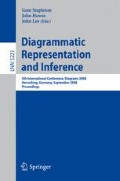Abstract
Although previous research has demonstrated that diagrams are powerful tools for problem solving, studies relating to educational practices indicate that students manifest various problems in diagram use. There are studies that have proposed teaching methods to address these problems, but these methods are not fully integrated with the school curriculum. This paper reports on the development of an instruction and support program to promote students’ spontaneous use of diagrams as part of a school curriculum. The program was provided to students in the first grade of a public high school in collaboration with the teachers. Findings from a survey and interviews with the students showed that, following the program, their daily learning behaviors involving diagram use improved. These findings suggest the effectiveness of providing graphic literacy education as part of the school curriculum.
Access this chapter
Tax calculation will be finalised at checkout
Purchases are for personal use only
References
Larkin, J.H., Simon, H.A.: Why a diagram is (sometimes) worth ten thousand words. Cognitive Science 11, 65–99 (1989)
Schoenfeld, A.H.: Mathematical problem solving. Academic Press, San Diego (1985)
Ichikawa, S.: Benkyouhouga kawaru hon [A book about changing the approach to learning]. Iwanami Press, Tokyo (2000)
Uesaka, Y., Manalo, E., Ichikawa, S.: What kinds of perceptions and daily learning behaviors promote students’ use of diagrams in mathematics problem solving? Learning and Instruction 17, 322–335 (2007)
Uesaka, Y.: Suugakutekimondainioite zuhyounoriyouwo unagasu kainyuuhohouno kentou [How to promote the spontaneous use of diagrams when solving math word problems]. In: The Annual Conference of Japanese Educational Psychology, p. 500. Preparatory Committee, Osaka (2003)
Uesaka, Y., Manalo, E.: Active comparison as a means of promoting the development of abstract conditional knowledge and appropriate choice of diagrams in math word problem solving. In: Barker-Plummer, D., Cox, R., Swoboda, N. (eds.) Diagrams 2006. LNCS (LNAI), vol. 4045, pp. 181–195. Springer, Heidelberg (2006)
Author information
Authors and Affiliations
Editor information
Rights and permissions
Copyright information
© 2008 Springer-Verlag Berlin Heidelberg
About this paper
Cite this paper
Uesaka, Y., Manalo, E. (2008). School Curriculum Development to Promote Student Spontaneous Diagram Use in Problem Solving. In: Stapleton, G., Howse, J., Lee, J. (eds) Diagrammatic Representation and Inference. Diagrams 2008. Lecture Notes in Computer Science(), vol 5223. Springer, Berlin, Heidelberg. https://doi.org/10.1007/978-3-540-87730-1_58
Download citation
DOI: https://doi.org/10.1007/978-3-540-87730-1_58
Publisher Name: Springer, Berlin, Heidelberg
Print ISBN: 978-3-540-87729-5
Online ISBN: 978-3-540-87730-1
eBook Packages: Computer ScienceComputer Science (R0)

